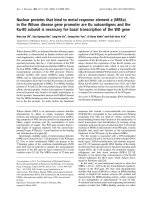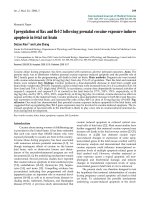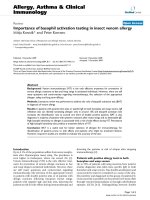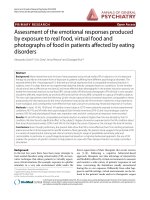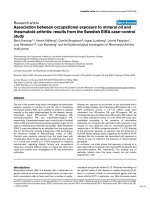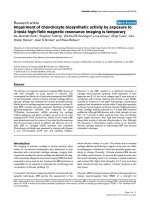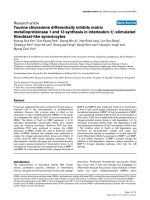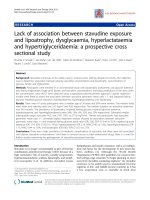Báo cáo y học: " Importance of cumulative exposure to elevated cholesterol and blood pressure in development of atherosclerotic coronary artery disease in systemic lupus erythematosus: a prospective proof-of-concept cohort study" pdf
Bạn đang xem bản rút gọn của tài liệu. Xem và tải ngay bản đầy đủ của tài liệu tại đây (224.97 KB, 44 trang )
This Provisional PDF corresponds to the article as it appeared upon acceptance. Copyedited and
fully formatted PDF and full text (HTML) versions will be made available soon.
Importance of cumulative exposure to elevated cholesterol and blood pressure
in development of atherosclerotic coronary artery disease in systemic lupus
erythematosus: a prospective proof-of-concept cohort study
Arthritis Research & Therapy 2011, 13:R156 doi:10.1186/ar3473
Mandana Nikpour ()
Murray B Urowitz ()
Dominique Ibanez ()
Paula J Harvey ()
Dafna D Gladman ()
ISSN 1478-6354
Article type Research article
Submission date 3 June 2011
Acceptance date 29 September 2011
Publication date 29 September 2011
Article URL />This peer-reviewed article was published immediately upon acceptance. It can be downloaded,
printed and distributed freely for any purposes (see copyright notice below).
Articles in Arthritis Research & Therapy are listed in PubMed and archived at PubMed Central.
For information about publishing your research in Arthritis Research & Therapy go to
/>Arthritis Research & Therapy
© 2011 Nikpour et al. ; licensee BioMed Central Ltd.
This is an open access article distributed under the terms of the Creative Commons Attribution License ( />which permits unrestricted use, distribution, and reproduction in any medium, provided the original work is properly cited.
Importance of cumulative exposure to elevated cholesterol and blood
pressure in development of atherosclerotic coronary artery disease in
systemic lupus erythematosus: a prospective proof-of-concept cohort
study
Mandana Nikpour
1,2
, Murray B Urowitz
1,#
, Dominique Ibanez
1
, Paula J Harvey
3
and
Dafna D Gladman
1
.
1
University of Toronto Lupus Clinic and the Centre for Prognosis Studies in the
Rheumatic Diseases, Toronto Western Hospital, 399 Bathurst Street, Toronto, ON,
M5T 2S8, Canada
2
The University of Melbourne Departments of Medicine and Rheumatology, St.
Vincent's Hospital, 41 Victoria Parade, Fitzroy, Melbourne, Victoria, 3065, Australia
3
Division of Cardiology and Clinical Pharmacology, Toronto Western Hospital, 399
Bathurst Street, Toronto, ON, M5T 2S8, Canada
#
Corresponding author:
Abstract
Introduction: Previous studies have shown that traditional risk factors such as
hypercholesterolemia and hypertension account for only a small proportion of the
dramatically increased risk of atherosclerotic coronary artery disease (CAD) in systemic
lupus erythematosus (SLE). However, in these studies, exposure to risk factors was
measured only at baseline. In this study, our objective was to compare measures of
cumulative exposure with remote and recent values for each of total cholesterol (TC),
systolic (SBP) and diastolic (DBP) blood pressure in terms of ability to quantify risk of
atherosclerotic CAD in patients with SLE.
Methods: Patients in the Toronto lupus cohort had TC and BP measured at each clinic
visit and were followed prospectively for the occurrence of CAD. For each patient,
arithmetic mean, time-adjusted mean (AM) and area-under-the-curve (AUC) were
calculated for serial TC, SBP and DBP measurements. Proportional hazards regression
models were used to compare these summary measures with recent and first available
(‘remote’) measurements in terms of ability to quantify risk of CAD events, defined as
myocardial infarction, angina or sudden cardiac death.
Results: There were 991 patients with mean±SD of 19±19 TC measurements per patient.
Over a follow-up of 6.7±6.4 years, there were 86 CAD events. While remote TC was not
significantly predictive of CAD, mean and AM TC were more strongly predictive (hazard
ratio [HR] 2.07, P=0.003) than recent TC (HR 1.86, P=0.001). AUC TC was not
predictive of CAD. A similar pattern was seen for DBP and SBP. Older age, male sex,
higher baseline and recent disease activity score, and corticosteroid use also increased
CAD risk while antimalarials were protective.
Conclusions: In contrast to the population-based Framingham model, first available TC
and BP are not predictive of CAD among patients with SLE, in whom measures
reflecting cumulative exposure over time are better able to quantify CAD risk. This is an
important consideration in future studies of dynamic risk factors for CAD in a chronic
relapsing-remitting disease such as SLE. Our findings also underpin the importance of
adequate control of SLE disease activity while minimising corticosteroid use, and
highlight the cardioprotective effect of antimalarials.
Keywords: Systemic lupus erythematosus, atherosclerosis, coronary artery disease, risk
factors
Introduction
Systemic lupus erythematosus (SLE) is associated with a dramatically increased risk of
atherosclerotic coronary artery disease (CAD) such that women with SLE aged 34 to 44
years are over 50 times more likely to develop myocardial infarction (MI) than age-
matched peers [1]. Traditional risk factors measured at baseline, as defined in the
Framingham model, do not fully account for this increased risk [2].
In the general population, it has been shown that recent and remote blood pressure (BP)
predict cardiovascular risk incrementally over current BP [3]. In an inception cohort of
patients with SLE, those with sustained hypercholesterolemia in the first 3 years of their
disease, were shown to be at greatest risk of cardiovascular events over 12 to 14 years
follow-up, compared with those who had persistently normal cholesterol or ‘variable’
hypercholesterolemia in the first 3 years of disease [4]. We have previously shown that
both TC and BP take a variable course in patients with SLE and that almost half of the
total variance over time in both TC and BP is seen within rather than between patients
[5]. These findings suggest that the risk of future coronary events might be best
quantified using strategies that take into account multiple measurements of risk factors
over time.
In this prospective proof-of-concept cohort study, we sought to compare ‘summary
measures’ of cumulative exposure to TC, SBP and DBP, with single-point-in-time
measurements of these risk factors (both recent and remote), in terms of ability to
quantify CAD risk.
Materials and methods
Patients
Patients attending the University of Toronto lupus clinic are routinely seen at two- to six-
monthly intervals wherein clinical and laboratory data, including TC, systolic blood
pressure (SBP) and diastolic blood pressure (DBP) levels are obtained and recorded
according to a set protocol. Patients are followed prospectively for the occurrence of
CAD events. In this study, we included patients who had two or more measurements of
TC, SBP and DBP taken before a CAD event (or last visit), in whom the gap between
measurements did not exceed 18 months. Patients with a history of CAD prior to the start
of the study were excluded. All patients fulfilled four or more of the American College of
Rheumatology classification criteria for SLE, or had three criteria and a typical lesion of
SLE on skin or renal biopsy [6, 7]. Informed consent was obtained from all participants
and the study was approved by the research ethics board of the University Health
Network.
Methods
Measurement of TC, SBP and DBP
Each measurement of TC, SBP and DBP was tied to a clinic visit. TC was measured in
plasma using a commercial assay (Boehringer Mannheim kit 236691 Indianapolis, IN)
and recorded in mmol/L. As there are only small, clinically insignificant differences in
TC when measured in the fasting or non-fasting state, non-fasting samples were used [8].
Systolic and diastolic blood pressures (SBP and DBP) were measured in millimeters of
mercury (mmHg) at every visit using a manual sphygmomanometer. The patient was
allowed to rest for 5 minutes in the sitting position. The reading was taken on the right
arm, supported at the level of the heart. Korotkoff phase V (disappearance) was recorded
as DBP.
Calculation of ‘summary measures’ of TC, SBP and DBP
For each of TC, SBP and DBP, an arithmetic mean of all available measurements in each
patient was calculated as the sum of all individual measurements divided by the total
number of measurements. In each patient, for each of TC, SBP and DBP, a time-adjusted
mean (AM) was also calculated using the formula:
x
i
+x
i−1
2
t
i
i= 2
n
∑
t
i
i
=
2
n
∑
where x
i
is the level of the variable at visit i and t
i
is the time interval between visit i and
i-1. By incorporating the time interval between measurements in its calculation, the AM
takes into account the length of time that TC, SBP and DBP are presumed to have
remained at a particular level. The arithmetic mean and AM were reported in mmol/L for
TC and mmHg for SBP and DBP. In each patient, for each of TC, SBP and DBP, area-
under-the-curve (AUC) was calculated using integral calculus. AUC is reported in
mmol/L multiplied by t and mmHg multiplied by t for each of TC and BP, respectively,
where t is the unit of time, in this case months. For any given visit (V
i
), the ‘summary
measure’ for each of TC, SBP and DBP was calculated from the first study visit (V
1
) up
to and including the visit before (V
i-1
), thus ensuring that for all time intervals exposure
preceded outcome. The last visit (V
L
) was either a visit at which a CAD event was
recorded or the last clinic visit as of August 2008 in those who remained CAD-free.
Covariates
Covariates included in the proportional hazards models were sex, age, disease duration,
disease activity score (Systemic Lupus Erythematosus Disease Activity Index 2000;
SLEDAI-2K), anti-phospholipid antibodies, ‘other’ classic cardiovascular risk factors
namely diabetes and smoking, medications including corticosteroids, antimalarials,
immunosuppressives, anti-hypertensives and lipid-lowering therapy (‘statins’), all
recorded at baseline, and at each and every visit. Age and disease duration (from
diagnosis to V
i
) were reported in years. SLEDAI-2K is an organ-weighted index of
disease activity, scored from 0 to 105, with higher scores indicating more active disease
[9]. Antimalarials included chloroquine and hydroxychloroquine. Immunosuppressives
included methotrexate, azathioprine, mycophenolate mofetil, cyclosporine and
cyclophosphamide. Anti-hypertensives included diuretics, beta blockers, calcium channel
blockers, angiotensin converting enzyme inhibitors and angiotensin type II receptor
blockers. The cumulative corticosteroid dose over the period of follow-up from study
entry (V
1
) to the last visit (V
L
) was calculated and reported in grams. Use of all other
medications was reported categorically at each visit, irrespective of dose. Diabetes was
defined as fasting plasma glucose > 7.0 mmol/L or diabetes therapy ever. Current
smoking was defined as smoking an average of one or more cigarette/s per day in the past
month.
Outcome variables
CAD events were angina pectoris, myocardial infarction (MI) and sudden cardiac death.
MI was defined as one of definite electrocardiographic (ECG) abnormalities, or typical
symptoms with probable ECG abnormalities and abnormal enzymes (≥ 2 times upper
limit of normal), or typical symptoms and abnormal enzymes. Angina pectoris was
defined as severe pain or discomfort over the upper or lower sternum or anterior left chest
and left arm, of short duration, relieved by rest or vasodilators in the absence of active
SLE, or in the presence of atherosclerotic vascular disease elsewhere, for example
atherosclerotic peripheral vascular or cerebrovascular disease. The diagnosis of angina
and MI required confirmation by a cardiologist. Sudden cardiac death was defined as
death with undetermined cause but presumed cardiac.
A CAD event that occurred between V
i
and V
i+1
was recorded at V
i+1
. For patients who
had more than one CAD event, only the first was used in analysis. Some patients may
have had both angina and MI recorded for the first time at a particular visit; this was
treated as only one event rather than two.
Univariate comparisons
For each of the TC and BP models, univariate comparisons of demographic, disease and
treatment related variables and traditional cardiac risk factors in patients who had CAD
events and those that remained CAD-free were performed using t-tests for continuous
variables and chi-square tests for categorical variables. In case of non-normally
distributed data, Mann Whitney U tests were used for continuous variables. Two-sided p
values (p) ≤ 0.05 were considered to be significant.
Time-constant regression models
For each of TC, SBP and DBP, two time-constant proportional hazards models were run.
Variables in the first model included first available (‘baseline’) measurement of TC (or
SBP, DBP), along with sex, age, SLEDAI-2K score at study entry (V
1
or ‘baseline’) and
anti-phospholipid antibodies, diabetes, smoking, corticosteroid, antimalarial,
immunosuppressive, antihypertensive and lipid-lowering medication use ‘ever’ from V
1
to V
L-1
. The second model included the average (arithmetic mean) of the first two
available measurements of TC (or SBP or DBP) and all covariates included in the first
Cox model.
Time-dependent regression models
For each of TC, SBP and DBP, we also ran four time-dependent proportional hazards
regression models. In the first model, recent measurements of TC (or SBP or DBP) was
used in a dynamic manner, varying from visit to visit. In the remaining three models
summary measures (mean, AM, AUC) were used in a time-dependent manner, i.e.
updated from visit to visit. Covariates in these models included sex, age, SLEDAI-2K
score, anti-phospholipid antibodies, diabetes, smoking, corticosteroid, antimalarial,
immunosuppressive, anti-hypertensive and lipid-lowering medication use, also treated in
a time-dependent fashion, i.e. updated from visit to visit. For each of TC, SBP and DBP
at each visit, single point, mean and AM measurements were strongly correlated.
Therefore, each summary measure was analysed in a separate model.
Both time-constant and time-dependent models are reported as hazard ratios (HRs) with
accompanying 95% confidence interval (95% CI) and p value, for each of the predictor
variables and covariates. All statistical analyses were performed using the SAS software
version 9.1 (SAS Institute Inc., Cary, North Carolina, USA).
Results
Characteristics of the patients in this study are presented in Table 1. Overall, the BP
dataset contained 991 patients, while the TC dataset comprised 956 patients. In each
dataset patients were mostly female (88%) and mostly Caucasian (70%). There were a
total of 94 coronary events (75 angina, 25 MI and 2 sudden cardiac deaths; 8 had both
angina and MI) in the BP dataset, while the TC dataset contained 86 coronary events (71
angina, 20 MI and 2 sudden cardiac deaths; 7 had both angina and MI). The mean±SD
age and disease duration at entry into the study were very similar for both datasets
(37.1±14.0 and 6.1±7.9 years respectively, for the BP dataset). Likewise, mean±SD
SLEDAI-2K score and Systemic Lupus Erythematosus International Collaborating
Clinics / American College of Rheumatology Damage Index (SLICC/ACR-DI) at study
entry were similar in the two datasets (9.2±7.5 and 0.5±1.2, respectively, for the BP
dataset), indicating moderate disease activity and minimal disease-related damage [10].
For each dataset, at entry into the study, over 60% of patients were taking corticosteroids,
while approximately 40% were on antimalarials and 25% were taking
immunosuppressives. In each dataset, at the start of the study, approximately 22% of
patients were hypertensive, 40% had hypercholesterolemia, 3% had diabetes and 19%
were smokers. At study start, in each dataset, 25% were on antihypertensives and 5% on
lipid-lowering medications.
Summary measures for BP
The calculation of summary measures was based on 19,579 individual measurements of
SBP and DBP, with a mean±SD of 20±20 (median 13) serial measurements per patient.
The mean±SD (median) time interval between measurements was 4.2±2.3 (3.4) months.
The mean±SD (median) time from study start to the visit before a CAD event (or last
clinic visit) was 6.5±6.7 (4.2) years. The mean±SD (median) length of follow-up from
study start to CAD event (or last clinic visit) was 7.0±6.7 (4.6) years. Among all patients,
the mean SBP at the start of study was 123.9±19.4 mmHg while the mean DBP at the
start of study was 77.6±12.3 mmHg.
Summary measures for TC
The calculation of summary measures was based on 17,936 individual measurements of
TC, with a mean±SD of 19±19 (median 12) serial measurements per patient. The
mean±SD (median) time interval between TC measurements was 4.3±2.3 (3.6) months.
The mean±SD (median) time from study start to the visit before a CAD event (or last
clinic visit) was 6.3±6.4 (4.2) years. The mean±SD (median) length of follow-up from
study start to CAD event (or last clinic visit) was 6.7±6.4 (4.6) years. Among all patients,
the mean TC level at the start of study was 5.3±1.6 mmol/L.
Univariate comparisons
Univariate comparisons of patients with and without CAD event for each of the BP and
TC models are presented in Table 2. In the BP models, patients who experienced CAD
events were more likely to be Caucasian (87.2% vs. 68.6%, p=0.004), older (46.0±13.2
vs. 36.6±13.9 years, p<0.0001), menopausal (44.4% vs. 23.7%, p=0.0001), hypertensive
(31.0% vs 14.4%, p<0.0001) and on corticosteroids (76.7% vs. 68.5%, p=0.02) at the
start of the study. Patients with CAD events were also more likely to have been older at
lupus diagnosis (39.0±14.1 vs. 30.1±13.5 years, p<0.0001) and to have anti-phospholipid
antibodies (75.8% vs. 61.1%, p=0.006), hypertension (82.6% vs. 43.7%, p<0.0001),
hypercholesterolemia (91.9% vs. 68.6%, p<0.0001) and diabetes mellitus (15.1% vs.
6.7%, p=0.005) during follow-up, than those who remained CAD-free. In addition, they
were more likely to be treated with corticosteroids (94.2% vs 77.7%, p=0.0003) at higher
cumulative doses (42.3±34.4 vs. 31.7±34.7 g, p=0.006), anti-hypertensives (90.8% vs.
72.9%, p=0.0008) and lipid-lowering medications (61.8% vs. 26.5%, p<0.0001) during
follow-up. Patients with CAD events were less likely to have been exposed to
antimalarials during follow-up (59.3% vs. 71.5%, p=0.02).
In the TC models, univariate comparison of patients with and without CAD outcomes
revealed results that were similar to the BP models (Table 2). TC level at study start
(5.85±1.62 vs. 5.19±1.56 mmol/L, p=0.0002), average of first two TC levels (5.91±1.53
vs. 5.19±1.49 mmol/L, p<0.0001), and mean (5.72±1.23 vs. 4.95±1.11 mmol/L,
p<0.0001), AM (5.72±1.23 vs. 4.94±1.11, p<0.0001) and AUC (15,806±13,063 vs.
11,1117±11,976 mmol/L months, p=0.0006) of all serial TC levels were higher in
patients who had CAD events than in those who remained CAD-free.
In both the BP and TC datasets, patients with CAD events were more likely to have
musculoskeletal, cutaneous, renal and nervous system manifestations of lupus and were
also more likely to have vasculitis, serositis and fever during the course of their disease.
However, there was no difference in the prevalence of chronic renal insufficiency, based
on SLICC/ACR DI definition [10], among those with and without CAD (5.3% vs 7.1%,
p=0.51 in the BP dataset).
Proportional hazards multiple regression models
TC models
Table 3 shows the results of the proportional hazards models for CAD events using
various measures of TC. In the time-constant models (columns 1 and 2), neither first
available (‘remote’) TC nor the average of first two TC levels were significantly
associated with CAD event. However, in these models, male sex (HR=2.02, p=0.02), age
(HR=1.06, p<0.0001) and SLEDAI-2K (HR=1.03, p=0.04) at study start (baseline), and
steroid use ever (HR=4.17, p=0.003) were significantly associated with CAD event. Anti-
malarial use ever was protective against CAD (HR=0.50, p=0.003).
In time-dependent models (Table 3, columns 3 to 5 inclusive), most recent (HR=1.22,
p=0.01), mean (HR=1.22, p=0.04) and AM (HR=1.22, p=0.03) TC at each visit were
significantly associated with CAD event. When only the significant covariates were
included in the models (Table 4), mean and AM TC were more strongly predictive of
CAD (HR = 2.07, p=0.003 for both) than recent TC (HR=1.86, p=0.001). In these
models, other significant covariates included male sex (HR=1.84, p=0.04, in recent TC
model), age (HR=1.06, p<0.0001 for all three models), SLEDAI-2K score (HR=1.09,
p<0.0001 for all three models), steroid use (HR = 1.85 for and 1.89 for mean and AM TC,
p=0.03 for all three models) and hypertension at each visit (HR = 1.57, p=0.06 for both
mean and AM TC models). AUC TC (Table 3, last column) was not significantly
associated with CAD.
SBP models
Results of the proportional hazards models for CAD outcomes using various measures of
systolic blood pressure (SBP) are presented in Table 5. In the time-constant models
(columns 1 and 2), neither first available (‘remote’) SBP nor the average of first two SBP
were associated with CAD event. However, in these models, male sex (HR = 2.01,
p=0.02 for first-available SBP model, HR = 2.04, p=0.02 for average-of-first-two SBP
model), age (HR=1.05, p<0.0001) and SLEDAI-2K (HR=1.03, p=0.01) at baseline, and
steroid use ever (HR=2.73 for first available and 2.74 for average of first two SBP,
p=0.03) were significantly associated with CAD event. Anti-malarial use ever was
protective against CAD (HR=0.59, p=0.02). Disease duration, elevated TC and
immunosuppressive use at baseline were not significantly associated with CAD.
In time-dependent models (Table 5, columns 3 to 5 inclusive), mean (HR = 1.025,
p=0.004) and AM (HR = 1.024, p=0.004) SBP at each visit were significantly associated
with CAD event, with the same HR for each of these summary measures of SBP. In
these models, other significant covariates included male sex (HR=1.87, p=0.04, for recent
SBP model), age (HR=1.06, p<0.0001 for most recent SBP, HR=1.04, p<0.0001 for
mean and AM SBP), SLEDAI-2K score (HR=1.09, p<0.0001 for all three models) and
elevated cholesterol (HR = 1.72 for most recent, 1.68 for mean and 1.69 for AM SBP,
p=0.03 for all three models) at each visit. AUC SBP (Table 5, last column) was not
significantly associated with CAD.
DBP models
Results of the proportional hazards models for CAD outcomes using various measures of
diastolic blood pressure (DBP) were similar to the SBP models and are presented in
Table 6.
In each of the multiple regression analyses presented in Tables 3 to 6, anti-phospholipid
antibodies, diabetes and smoking were consistently statistically insignificant and
therefore removed from the final models in order to maximise statistical power. Data on
antihypertensive use and lipid lowering therapy were incomplete for a proportion of
visits. In subgroup analysis of these smaller datasets, neither antihypertensives nor lipid-
lowering medications were significantly associated with CAD events (data not shown).
Discussion
Through the use of proportional hazards regression modelling in a large sample of over
950 patients, in whom collectively over 18,000 serial measurements of TC and BP were
taken over a mean duration of 6.3 years, we were able to demonstrate and quantify the
association between several important risk factors and CAD events in SLE.
Foremost, this study highlights the important role of traditional risk factors such as
elevated TC and BP in SLE-related CAD, and demonstrates a continuum of risk
associated with these variables across the range of possible values they may assume.
Previous studies have shown that traditional risk factors such as hypercholesterolemia
and hypertension account for only a small proportion of the increased risk of CAD in
SLE. However, in these studies TC and BP were measured at baseline, in keeping with
the premise of the Framingham model. Here we have shown that this ‘remote’ measure of
exposure to TC, SBP or DBP is not predictive of CAD outcome among patients with
SLE. Furthermore, recent measurements of TC and BP, which are also taken at a single
point in time, are not able to quantify CAD risk to the same degree as ‘summary
measures’, which capture cumulative exposure to these risk factors over the course of
disease. We have previously shown that unlike the general population wherein TC and
BP ‘track’ over time, in patients with SLE, these risk factors take a dynamic course,
varying due to changes in disease activity and treatment [5].
In this study cumulative exposure to TC, SBP and DBP was measured using three
‘summary measures’, namely arithmetic mean, time-adjusted mean (AM) and area-under-
the-curve (AUC). Time-dependent proportional hazards regression models were then
applied to these summary measures. In this way a sense of cumulative exposure was
captured in two ways; firstly in the form of a summary measure and secondly by
determining the hazard related to this summary measure for an interval just prior to each
and every sequential visit. In these time-dependent models, a sense of cumulative
exposure to other covariates including disease activity score, corticosteroids and
antimalarials was also captured through the use of serial measurements of these variables,
updated from one visit to the next.
For each of TC, SBP and DBP, mean and AM summary measures were significantly
predictive of CAD event. In addition, the HR and accompanying p value of mean
summary measures was the same as for AM summary measures in the case of each of TC,
SBP and DBP. This is likely related to the fact that overall, in this context where
measurements were taken frequently, mean and AM values were very similar for each
patient. However, when applied to a setting where measurements are more irregular and
infrequent, the AM, which is weighted for the interval between measurements may be
expected to more accurately reflect cumulative risk exposure and hence the overall risk of
CAD. In the case of TC, a hazard ratio of 2.07 (p=0.003) means that for every 1 mmol/L
increase in mean (or AM) plasma TC level, the hazard of a CAD outcome increases 2.07
fold. In the case of SBP, a hazard ratio of 1.025 means that for every 1 mmHg increase in
mean SBP, the hazard of CAD outcome increases 1.025 fold.
Likewise, in the case of DBP, a hazard ratio of 1.04 means that for every 1 mmHg
increase in mean (or AM) DBP, the hazard of CAD outcome increases 1.04 fold. SBP and
DBP are highly correlated and based on our analyses, either one or the other may be used
to quantify CAD risk in patients with SLE.
AUC is very closely tied to length of follow-up, and for any given variable may only
become larger over time. As such it does not provide a sense of rise and fall in the
variable of interest. Furthermore, it is not measured in the original units of the variable
from which it is derived. These reasons may underlie the lack of association between
AUC measures and CAD outcomes among SLE patients in our study.
In this proof-of-concept study, our chosen lipid marker of CAD risk was TC. In general,
low-density lipoprotein cholesterol (LDL-C) is deemed the primary target of lipid-
lowering therapy [11]. In the Toronto lupus cohort, measurement of non-fasting TC has
been routine practice at every visit since 1975. However, measurement of lipid and
lipoprotein subfractions is a more recent addition to the data collection protocol and
performed only once yearly due to the need for a fasting sample. In order to derive
summary measures and test their ability to quantify CAD risk, we required a very large
dataset inclusive of a relatively large number of CAD outcomes. The TC and BP datasets
fulfilled these methodological requirements. In future, summary measures derived in this
study may be applied to other risk factors such as LDL-C.
How many measurements are enough to provide a valid summary measure and how often
should these measurements be taken in patients with SLE? In this study, the average of
first two TC (or SBP or DBP) measurements was not significantly predictive of CAD
outcome. Therefore, ideally three or more serial measurements should be sought.
Although in this study the mean gap between measurements used to calculate summary
measures was 4.3 months, patients in whom the gap between one or more serial
measurements exceeded 18 months were not included in the analyses. Further studies are
required to determine the optimal number and frequency of measurements of TC and BP
in evaluating CAD risk in SLE.
This study has provided several important insights regarding the role of demographic,
disease and treatment-related variables in SLE-related CAD. The most noteworthy are the
increased risk of CAD with increasing disease activity and corticosteroid use, and the
protective effect of antimalarials.
We found that for every unit increase in recent SLEDAI-2K disease activity score, the
risk of CAD event by the time of the subsequent visit increased almost 10%. An increase
in SLEDAI-2K score of 4 or more is generally deemed clinically significant [12]. This
means that a minimum clinically significant increase in recent disease activity score is
associated with approximately 46% increase in risk of CAD in the interval between
sequential visits. Ibanez et al. have previously shown that for every unit increase in the
time-adjusted mean SLEDAI-2K score (AMS), the hazard of a CAD outcome increases
1.08 fold [13]. Collectively, these associations highlight the underpinning role of
inflammation in SLE-related CAD.
Our patients with CAD events had greater disease activity at baseline and during follow-
up, manifest in a multitude of organ systems including musculoskeletal, cutaneous, renal,
neural, vascular and serosal. As the overall prevalence of chronic renal impairment was
low and did not differ among groups with and without CAD, the association between
disease activity and events seen in this study cannot be attributed to nephritis or renal
impairment alone.
In studies of coronary risk factors in SLE, it is often difficult to tease apart the effect of
corticosteroids from disease activity and traditional cardiac risk factors. In previous
studies, longer duration of steroid use has been shown to be an independent risk factor for
CAD in SLE [1, 14]. Using a retrospective chart review method, Karp et al. have shown
that a 10 mg increase in the average daily prednisone-equivalent dose in the preceding
year is independently associated with a 16% increase in the estimated 2-year CAD risk
[15]. Here, we have quantified CAD risk in patients with SLE using prospectively
collected data. Patients with CAD events received a significantly greater cumulative dose
of corticosteroids during follow-up than those who remained CAD-free. In the regression
models for first-available and average-of-first-two TC levels, exposure to corticosteroids
at any time during the course of disease, irrespective of dose and duration of use, was
associated with a dramatic 4.17 fold increased risk of CAD event, independently of other
risk factors. This HR was reduced to 1.85, but remained substantial and statistically
significant, in the time-dependent models wherein recent exposure to corticosteroids was
related to CAD event.
In time-constant models for TC and BP, antimalarial use during the course of SLE was
associated with a remarkable 50% to 59% reduction in hazard of CAD event. The lack of
a significant association between recent antimalarial use and CAD in the time-dependent
models may point to a beneficial effect with long-term rather than short-term use. In
previous studies, use of antimalarials has been associated with a reduction in TC level [5,
14, 16, 17]. However, ours is one of only a few studies where the use of antimalarials has
been linked with a reduction in the risk of actual CAD events [18, 19]. Furthermore, the
halving of coronary risk makes a strong case for the use of antimalarials in patients with
SLE, not only to control disease activity but also for cardioprotection.
As in previous studies, we have shown that male sex and older age are associated with
increased hazard of CAD event. In previous studies, anti-phospholipid antibodies,
diabetes and smoking have been shown to be independent risk factors for CAD events in
SLE [20]. However, in this study, in multiple regression analysis, such an association was
not found, possibly due to the limited number of patients who smoke or have diabetes or
anti-phospholipid antibodies. This study is not an exhaustive evaluation of traditional risk
factors, and the role of other variables such as family history of ischemic heart disease,
body mass index (BMI) and waist:hip ratio merit further investigation in future studies.
In summary, we have shown that elevated TC and BP are both potentially treatable risk
factors for CAD in SLE. Our study has highlighted the importance of frequent
measurements of BP and TC in management of patients with SLE. Whilst clinicians
might consider the need for change in treatment based on single TC and BP
measurements, their decision to actually do so should be made on the basis of the mean
of several measurements.
Conclusions
Overall, this study has both conceptual and practical significance. From a conceptual
point of view, our findings illustrate that in a systemic inflammatory disease, for a
dynamic risk factor such as TC or BP, summary measures such as mean and AM better
reflect cumulative exposure and hence better quantify CAD risk. This is an important
consideration in future studies of dynamic risk factors for CAD in a chronic relapsing-
remitting disease such as SLE and may be used to derive risk prediction models
specifically for SLE. From a practical point of view, this study has shown that assessment
of coronary risk related to TC and BP in patients with SLE relies on serial measurement
of these risk factors throughout the relapsing-remitting course of SLE. Additionally, this
study has shown that disease activity and corticosteroid use are CAD risk factors in SLE,
indicating that disease activity should be recognized and optimally controlled using the
minimum effective dose of corticosteroids. The demonstration of a cardioprotective
association of antimalarials highlights the staple role of this class of drugs in the
management of patients with SLE. Finally, this study has quantified the risk associated
with exposure to TC, SBP and DBP over time, emphasizing the importance of these
potentially treatable traditional risk factors in patients with SLE. Future efforts must be
directed towards determining TC and BP cut-points for CAD risk stratification
specifically among patients with SLE and the role of treatment of risk factors in reducing
the incidence of CAD events.
Abbreviations
ACR: American College of Rheumatology; AM: time-adjusted mean; AMS: adjusted
mean SLE disease activity index 2000; AUC: area under the curve; BP: blood pressure;
CAD: coronary artery disease; CI: confidence interval; DBP: diastolic blood pressure;
ECG: electrocardiographic; HR: hazard ratio; LDL-C: low-density lipoprotein
cholesterol; Max: maximum; Min: minimum; mm Hg: millimeters of mercury; mmol/L:
millimoles per liter; MI: myocardial infarction; SBP: systolic blood pressure; SD:
standard deviation; SLE: systemic lupus erythematosus; SLEDAI-2K: Systemic Lupus
Erythematosus Disease Activity Index 2000; SLICC/ACR DI: Systemic Lupus
Erythematosus International Collaborating Clinics / American College of Rheumatology
Damage Index; TC: total cholesterol.
Competing interests
The authors declare that they have no competing interests.
Authors' contributions
MN participated in the study design, collection and analysis of data, interpretation of
results, and preparation of manuscript. DDG and MBU participated in the study design,
collection of data, interpretation of results, and preparation of manuscript. DI participated
in the study design, analysis of data, interpretation of results, and preparation of
manuscript. PJH participated in the study design, interpretation of results, and preparation
of manuscript. All authors have read and approved the manuscript for publication.
Acknowledgements
This study was supported by the Centre for Prognosis Studies in The Rheumatic
Diseases, The Smythe Foundation, Lupus Flare Foundation, Ontario Lupus Association,
and The Lupus Society of Alberta. Dr. Nikpour was supported by the Arthritis Centre of
Excellence and the Geoff Carr Lupus Fellowship.
References
1. Manzi S, Meilahn EN, Rairie JE, Conte CG, Medsger TA, Jr., Jansen-
McWilliams L, D'Agostino RB, Kuller LH: Age-specific incidence rates of
myocardial infarction and angina in women with systemic lupus
erythematosus: comparison with the Framingham Study. Am J Epidemiol
1997, 145:408-415.
2. Esdaile JM, Abrahamowicz M, Grodzicky T, Li Y, Panaritis C, du Berger R, Cote
R, Grover SA, Fortin PR, Clarke AE, Senécal JL.: Traditional Framingham risk
factors fail to fully account for accelerated atherosclerosis in systemic lupus
erythematosus. Arthritis Rheum 2001, 44:2331-2337.
3. Vasan RS, D'Agostino RB, Sr.: Age and time need not and should not be
eliminated from the coronary risk prediction models. Circulation 2005,
111:542-545.
4. Bruce IN, Urowitz MB, Gladman DD, Hallett DC: Natural history of
hypercholesterolemia in systemic lupus erythematosus. J Rheumatol 1999,
26:2137-2143.
5. Nikpour M, Gladman DD, Ibanez D, Harvey PJ, Urowitz MB: Variability over
time and correlates of cholesterol and blood pressure in systemic lupus
erythematosus: a longitudinal cohort study. Arthritis research & therapy 2010,
12:R125.
6. Lee P, Urowitz MB, Bookman AA, Koehler BE, Smythe HA, Gordon DA,
Ogryzlo MA: Systemic lupus erythematosus. A review of 110 cases with
reference to nephritis, the nervous system, infections, aseptic necrosis and
prognosis. Q J Med 1977, 46:1-32.
7. Tan EM, Cohen AS, Fries JF, Masi AT, McShane DJ, Rothfield NF, Schaller JG,
Talal N, Winchester RJ: The 1982 revised criteria for the classification of
systemic lupus erythematosus. Arthritis Rheum 1982, 25:1271-1277.
8. Craig SR, Amin RV, Russell DW, Paradise NF: Blood cholesterol screening
influence of fasting state on cholesterol results and management decisions. J
Gen Intern Med 2000, 15:395-399.
9. Gladman DD, Ibanez D, Urowitz MB: Systemic lupus erythematosus disease
activity index 2000. J Rheumatol 2002, 29:288-291.
10. Gladman D, Ginzler E, Goldsmith C, Fortin P, Liang M, Urowitz M, Bacon P,
Bombardieri S, Hanly J, Hay E, Isenberg D, Jones J, Kalunian K, Maddison P,
Nived O, Petri M, Richter M, Sanchez-Guerrero J, Snaith M, Sturfelt G,
Symmons D, Zoma A: The development and initial validation of the Systemic
Lupus International Collaborating Clinics/American College of
Rheumatology damage index for systemic lupus erythematosus. Arthritis
Rheum 1996, 39:363-369.
11. Grundy SM, Cleeman JI, Merz CN, Brewer HB, Jr., Clark LT, Hunninghake DB,
Pasternak RC, Smith SC, Jr., Stone NJ: Implications of recent clinical trials for
the National Cholesterol Education Program Adult Treatment Panel III
guidelines. Circulation 2004, 110:227-239.
12. Gladman DD, Urowitz MB, Kagal A, Hallett D: Accurately describing changes
in disease activity in Systemic Lupus Erythematosus. J Rheumatol 2000,
27:377-379.
13. Ibanez D, Gladman DD, Urowitz MB: Adjusted mean Systemic Lupus
Erythematosus Disease Activity Index-2K is a predictor of outcome in SLE. J
Rheumatol 2005, 32:824-827.
14. Petri M, Lakatta C, Magder L, Goldman D: Effect of prednisone and
hydroxychloroquine on coronary artery disease risk factors in systemic lupus
erythematosus: a longitudinal data analysis. Am J Med 1994, 96:254-259.
15. Karp I, Abrahamowicz M, Fortin PR, Pilote L, Neville C, Pineau CA, Esdaile JM:
Recent corticosteroid use and recent disease activity: independent
determinants of coronary heart disease risk factors in systemic lupus
erythematosus? Arthritis Rheum 2008, 59:169-175.
16. Sachet JC, Borba EF, Bonfa E, Vinagre CG, Silva VM, Maranhao RC:
Chloroquine increases low-density lipoprotein removal from plasma in
systemic lupus patients. Lupus 2007, 16:273-278.
17. Wallace DJ, Metzger AL, Stecher VJ, Turnbull BA, Kern PA: Cholesterol-
lowering effect of hydroxychloroquine in patients with rheumatic disease:
reversal of deleterious effects of steroids on lipids. Am J Med 1990, 89:322-
326.
18. Goldberg RJ, Urowitz MB, Ibanez D, Nikpour M, Gladman DD: Risk factors for
development of coronary artery disease in women with systemic lupus
erythematosus. The Journal of Rheumatology 2009, 36:2454-2461.
19. Ruiz-Irastorza G, Ramos-Casals M, Brito-Zeron P, Khamashta MA: Clinical
efficacy and side effects of antimalarials in systemic lupus erythematosus: a
systematic review. Ann Rheum Dis, 69:20-28.
20. Gladman DD, Urowitz MB: Morbidity in systemic lupus erythematosus. J
Rheumatol Suppl 1987, 14 Suppl 13:223-226.

